Nervecentre V9.0 Help for Users
You can place a single order or an order for multiple services, using a mobile or desktop. You can place orders by folder, category, or order sets.
 About order sets
About order sets
An order set is a set of services that are commonly requested together. This could be for a condition or symptom, specialty, or a process. For example, you might have a set of relevant pathology and radiology investigations for patients admitted with abdominal pain. Order sets can be organised into groups, or folders.
The order sets you see depend on your organisation.
 About repeating orders
About repeating orders
When you place an order for an inpatient, you choose the collection service that collects the sample. Depending on your organisation, some collection services allow you to place repeat orders for the same test over the next 7 days.
For example, a patient needs a blood test every 2 days for the next week. When you place an order for a blood test, you complete a form. On the form, you choose a collection service.
If the collection service has:
-
Rounds
From Collection round, you can choose one or more rounds from the next 7 days.
For example, if you choose the afternoon round and evening round, Nervecentre places two orders. The samples for those orders are collected during those rounds.
The collection rounds and their times depend on your organisation.
-
Ad hoc collections
From Required collection time, you can choose a specific date and time for the first sample collection. This date can be more than 7 days into the future, but if you are placing repeat orders, this date must be in the next 7 days. If you don't choose a specific date and time, Nervecentre uses the current date and time.
From Repeats, you can choose one or more dates from the next 7 days after today for the repeat orders. The dates of the repeat orders must be after the date of the first order. The collection time for the repeat orders is the same as the collection time of the first order.
For example, you choose the first sample collection to be today, the 23rd September, at 10:00. You choose the repeat orders to be on the 24th and 30th September. Three orders are placed. The samples for those orders are collected on those dates all at 10:00.
 About Notify Results
About Notify Results
When you place an order, you might see a field called Notify Results. From Notify Results, you can choose who receives messages about updates to the order, and results.
If your organisation:
-
Has Nervecentre Messaging
You can send messages to your inbox, a consultant's inbox, or a shared inbox. When Nervecentre receives an update about an order, or results, Nervecentre sends a message to the recipient's inbox. You can view messages in your inbox on a mobile or desktop.
Read more about viewing messages
Nervecentre Messaging is available from V9.0.
-
Doesn't have Nervecentre Messaging
You can send alerts to your mobile, or another clinician's mobile. When Nervecentre receives an update about an order, or results, Nervecentre sends an alert to you, or another user. For example, to a clinician in a team such as H@N Hospital at Night. A multidisciplinary team of doctors and nurses working collaboratively to manage patient tasks in the out of hours periods.. When you receive an alert, a notification appears on your mobile.
 Choosing who receives messages about an order
Choosing who receives messages about an order
-
Follow the steps for placing an order.
-
When you reach the order form, find Notify Results.
-
From Notify Results, select one or more options.
If your organisation has Nervecentre Messaging:
-
To receive messages about an order, select Notify my Inbox.
-
To send messages about an order to the requesting consultant, select Notify Consultant's Inbox.
-
To send messages about an order to a shared inbox, select Notify Shared Inbox: n, where n is the name of the inbox.
If your organisation doesn't have Nervecentre Messaging:
-
To receive an alert about results on your mobile, select Notify Me. The button text depends on your organisation.
-
To send an alert about results to a relevant clinician's mobile, select Notify Relevant Clinician. For example, to a clinician in a team such as H@N Hospital at Night. A multidisciplinary team of doctors and nurses working collaboratively to manage patient tasks in the out of hours periods.. The button text depends on your organisation.
-
Placing orders on a mobile
 Placing a single order
Placing a single order
-
From your patient list, select a patient, or scan a patient's wristband.
-
From Investigations, select Orders.
-
Select .
-
Type to search for the service.
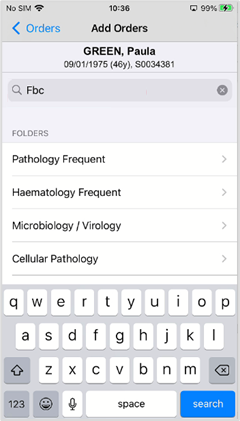
-
Select a service.
The service displays . Any information is displayed under the name.
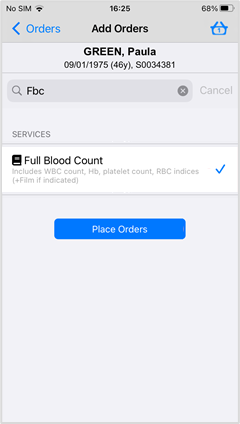
-
To remove a service that you don’t need, select .
-
To view an attached policy, select and hold , then select the policy name.
There can be multiple policies associated with an order.
-
Select Place Orders > Next.
-
Complete all the information needed.
Mandatory fields are marked .
If there are multiple orders and you need to enter different details for each, select Advanced to split the order form.
-
From INFECTION RISK, check the risk shown.
If INFECTION RISK isn't populated, or the information is incorrect, you can select INFECTION RISK and select or clear one or more infection risks. You can leave this field blank.
Select Confirm when you have finished.
-
When all information is complete select Submit.
You return to Orders. All orders statuses are shown on this screen.
 Placing an order for multiple services
Placing an order for multiple services
You can create an order that includes one or more services or samples.
The samples might not need to be taken at the same time. For example, blood samples might be taken immediately, but a swab might occur later that day, and an X-Ray the next day. All, however, can be ordered in a single transaction.
-
From your patient list, select a patient, or scan a patient's wristband.
-
From Investigations, select Orders.
-
Select .
-
Type to search for the service.
-
Select a service.
The service displays . Any information is displayed under the name.
updates to indicate you are placing one order.

-
To add more services:
-
Select to clear the search
-
Enter the next service you want to add to the order.
-
Select search.
-
Select a service.
updates to indicate you are placing two orders.
-
Repeat adding services until you have chosen all the services you need in the order
-
- To view the list of services you selected, select Place Orders or
.
- To remove a service that you don’t need, select .
-
Select Next.
-
Complete the order form.
Mandatory fields are marked .
If there are multiple orders and you need to enter different details for each, select Advanced to split the order form.
If there are multiple services being ordered together, there might be multiple forms. Nervecentre indicates how far you are through this process.

-
Select Submit.
You return to Orders. All orders statuses are shown on this screen.
 Placing an order using folders
Placing an order using folders
Folders group services to make it easier for you to find them. Folders might group services by pathway, such as stroke, or by commonality. The folders you see depend on your organisation. Services don't have to appear in a folder, and can appear in multiple folders.
-
From your patient list, select a patient, or scan a patient's wristband.
-
From Investigations, select Orders.
-
Select .
-
Select a folder from FOLDERS. Select folders until you reach services.
To return to the previous folder, select the folder name.
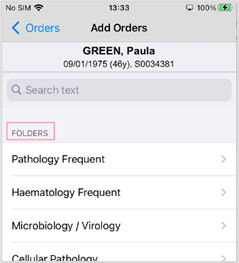
-
Select a service or order set.
The service displays . Any information is displayed under the name.
-
To remove a service that you don’t need, select .
-
To view an attached policy, select and hold , then select the policy name.
-
Select Place Orders > Next.
-
Complete the order form.
Mandatory fields are marked .
If there are multiple orders and you need to enter different details for each, select Advanced to split the order form.
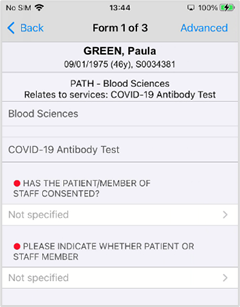
-
Select Submit.
You return to Orders. All orders statuses are shown on this screen.
 Placing an order by category
Placing an order by category
Categories are broad containers for services. All services belong to a category. Categories generally, and the categories you see, depend on your organisation.
-
From your patient list, select a patient, or scan a patient's wristband.
-
From Investigations, select Orders.
-
Select .
-
Select a category from BY CATEGORY. Select subcategories until you reach services.
To return to a previous category, select the category name.

-
Select a service.
The service displays . Any information is displayed under the name.
-
To remove a service that you don’t need, select .
-
To view an attached policy, select and hold , then select the policy name.
-
Select Place Orders > Next.
-
Complete the order form.
Mandatory fields are marked .
If there are multiple orders and you need to enter different details for each, select Advanced to split the order form.

-
Select Submit.
You return to Orders. All orders statuses are shown on this screen.
 Placing an order set
Placing an order set
-
From your patient list, select a patient, or scan a patient's wristband.
-
From Investigations, select Orders.
-
Select .
-
Scroll down and select Order set.
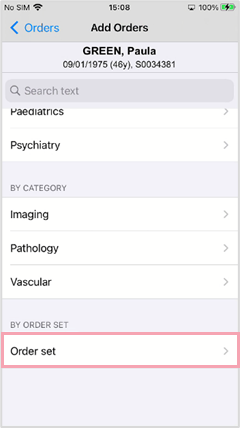
-
Select groups until you reach order sets.
-
Select an order set.
All the services within the order set are shown.
-
To remove any services that you don’t need, select to clear the option.
-
To view an attached policy, select and hold , then select the policy name.
-
Select Place Orders > Next.
-
Complete the order form.
Mandatory fields are marked .
If there are multiple orders and you need to enter different details for each, select Advanced to split the order form.

-
Select Submit.
You return to Orders. All orders statuses are shown on this screen.
 Placing outpatient orders
Placing outpatient orders
Orders for some services, such as X-rays or CT scans, are available to order prior to patient discharge.
You can only order services that are applicable to outpatients.
-
From your patient list, select a patient, or scan a patient's wristband.
-
From Investigations, select Orders.
-
Select .

-
Select Place outpatient order.
-
Follow the procedures above for placing orders.
If you try to order a service that isn't an outpatient order, what you see depends on your search method:
-
If you search for a service by typing, and the service isn't an outpatient order, the service doesn't appear.
-
If you search for a service by browsing categories, you see No services are available in this category.
-
If you search for a service by browsing folders, you see No services are available in this group.
-
If you try to place an order for an order set, you see Order set unavailable due to the following service issues. No Profile: n, where n is the name of the test.
-
Placing orders on a desktop
 Placing a single order
Placing a single order
-
From Inpatients > Patient List > double-click on a patient's name > Patient Detail, select Investigations.
-
Select .
-
Enter a service in Search.
You can enter the full name, the short code, or the alias.
-
Select a service from Services and acknowledge any alerts.
-
The service is listed in Orders To Place.
Services that display have been requested recently.
-
To view an attached policy, select .
-
To view information about a service, mouseover .
-
To remove a service, mouseover the service and select x.
-
-
Select Next.
The form for the service is shown.
To add or remove services, select Back.
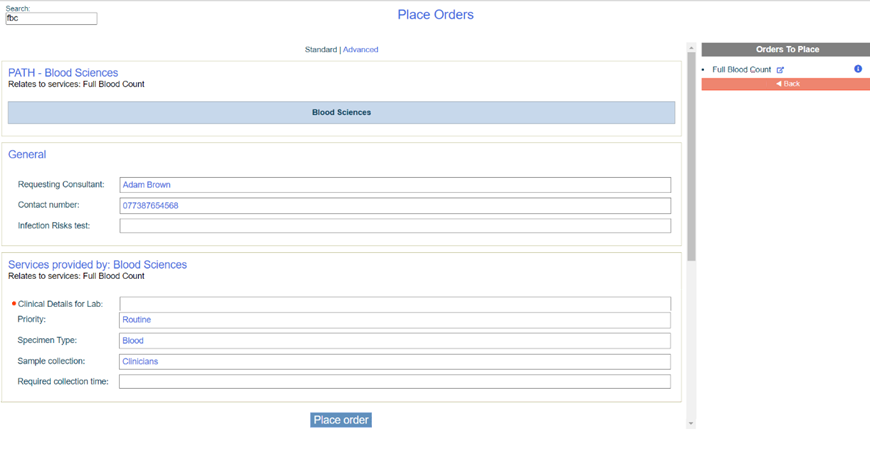
-
Optional: to enter a specific sample collection, or priority information for each order, select Advanced.
-
Complete all mandatory fields on the form.
Mandatory fields are marked .
-
Select Place order.
 Placing an order for multiple services
Placing an order for multiple services
You can create an order that specifies one or more services to be performed on the patient, or samples taken from the patient, in a single transaction.
The samples might not need to be taken at the same time. For example, blood samples might be taken immediately, but a swab might occur later that day, and an X-Ray the next day. All, however, can be ordered in a single transaction.
-
From Inpatients > Patient List > double-click on a patient's name > Patient Detail, select Investigations.
-
Select .
-
Enter a service in Search.
-
Select an order from Services and acknowledge any alerts.
-
To add additional orders, enter the service in Search.
-
Select an order from Services.
-
Acknowledge any alerts.
-
Selected services are listed in Orders To Place.
Services that display have been requested recently.
-
To view an attached policy, select .
-
To view information about a service, mouseover .
-
To remove a service, mouseover the service and select x.
-
-
Select Next.
The forms for each service are shown.
To add or remove services, select Back.

-
Optional: to enter a specific sample collection, or priority information for each order, select Advanced.
-
Complete all mandatory fields on the forms.
Mandatory fields are marked .
-
Select Place order.
 Marking a service or order set as a favourite
Marking a service or order set as a favourite
You can mark a service or order set as a favourite. You can place orders from your favourites.
Read more about placing an order from your favourites
-
From Inpatients > Patient List > double-click on a patient's name > Patient Detail, select Investigations.
-
Select .
-
Search or browse for a service or order set.
-
Enter a service or order set in Search.
You can enter the full name, the short code, or the alias.
-
From Folders, select folders until you reach Services.
-
From By category, select a service provider, then select categories until you reach Services.
-
From By order set, select Order sets.
-
-
Next to the name of the service or order set, select .
 Placing an order from your favourites
Placing an order from your favourites
-
From Inpatients > Patient List > double-click on a patient's name > Patient Detail, select Investigations.
-
Select .
-
From Favourites, select My Favourites.
A list appears with services and order sets you marked as favourites.
Read more about marking services and order sets as favourites
-
Select a service or order set.
-
Acknowledge any alerts.
-
Selected services are listed in Orders To Place.
-
To view an attached policy, select .
-
To view information about a service, mouseover .
-
To remove a service, mouseover the service and select x.
-
-
Select Next.
The forms for each service are shown.
To add or remove services, select Back.
-
Optional: to enter a specific sample collection, or priority information for each order, select Advanced.
-
Complete all mandatory fields on the forms.
Mandatory fields are marked .
-
Select Place order.
 Placing an order using folders
Placing an order using folders
Folders group services to make it easier for you to find them. Folders might group services by pathway, such as stroke, or by commonality. The folders you see depend on your organisation. Services do not have to appear in a folder, and can appear in multiple folders.
-
From Inpatients > Patient List > double-click on a patient's name > Patient Detail, select Investigations.
-
Select .
-
From Folders, select folders until you reach Services.

-
Select the required service.
-
Acknowledge any alerts.
-
Selected services are listed in Orders To Place.
-
To view an attached policy, select .
-
To view information about a service, mouseover .
-
To remove a service, mouseover the service and select x.
-
-
Select Next.
The forms for each service are shown.
To add or remove services, select Back.
-
Optional: to enter a specific sample collection, or priority information for each order, select Advanced.
-
Complete all mandatory fields on the forms.
Mandatory fields are marked .
-
Select Place order.
 Placing an order by category
Placing an order by category
Categories are broad containers for services. All services belong to a category. Categories generally, and the categories you see, depend on your organisation.
-
From Inpatients > Patient List > double-click on a patient's name > Patient Detail, select Investigations.
-
Select .
-
From By category, select the service provider.
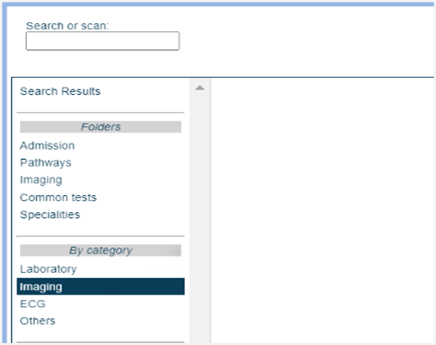
-
Select a category for the service provider from Categories.
-
Select categories until you reach Services.
-
Select one or more services and acknowledge any alerts.
-
Selected services are listed in Orders To Place.
-
To view an attached policy, select .
-
To view information about a service, mouseover .
-
To remove a service, mouseover the service and select x.
-
-
Select Next.
The forms for each service are shown.
To add or remove services, select Back.
-
Optional: to enter a specific sample collection, or priority information for each order, select Advanced.
-
Complete all mandatory fields on the forms.
Mandatory fields are marked .
-
Select Place order.
 Placing an order set
Placing an order set
-
From Inpatients > Patient List > double-click on a patient's name > Patient Detail, select Investigations.
-
From By order set, select Order sets.
-
To choose an order set:
-
Select one or more order sets.
Or
-
Select items from groups until you reach Order sets, then select one or more order sets.
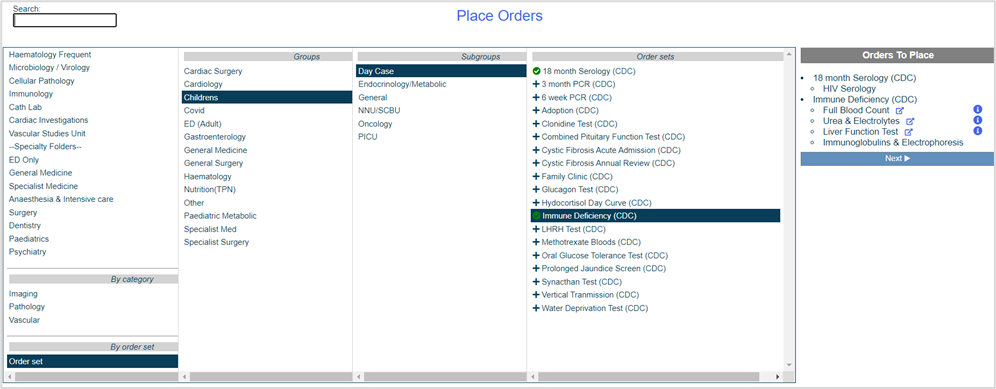
-
-
Acknowledge any alerts.
-
All the services in the selected order sets are listed in Orders To Place.
-
To view an attached policy, select .
-
To view information about a service, mouseover .
-
To remove a service, mouseover the service and select x.
-
-
Select Next.
The forms for each service are shown.
To add or remove services, select Back.
-
Optional: to enter a specific sample collection, or priority information for each order, select Advanced.
-
Complete all mandatory fields on the forms.
Mandatory fields are marked .
-
Select Place order.
 Placing outpatient orders
Placing outpatient orders
Orders for some services, such as X-rays or CT scans, are available to order prior to patient discharge.
You can only order services that are applicable to outpatients.
-
From Inpatients > Patient List > double-click on a patient's name > Patient Detail, select Investigations.
-
Select .
-
Select Place outpatient order.
-
Follow the procedures above for placing orders.
If you try to order a service that isn't an outpatient order, what you see depends on your search method:
-
If you search for a service by typing, and the service isn't an outpatient order, the service does not appear.
-
If you search for a service by browsing categories, you see No services are available in this category.
-
If you search for a service by browsing folders, you see No services are available in this group.
-
If you try to place an order for an order set, you see Order set unavailable due to the following service issues. No Profile: n, where n is the name of the test.
-
 Placing preadmission orders
Placing preadmission orders
If a patient has a preadmission, you can place preadmission orders. For example, you might place a preadmission order for a full blood count if the patient's GP called the hospital to let you know that the patient needs admitting, and you know the patient needs a full blood count when they arrive at the hospital.
-
From Inpatients > Patient List > double-click on a patient's name > Patient Detail, select Investigations.
-
Select .
-
Select Place preadmission order.
You might stay in Inpatients, or move to Outpatients. This depends on the patient's current context.
-
Follow the procedures above for placing orders.
Did you find this article helpful? Yes No
Sorry about that. Our help is a work in progress and we welcome any feedback.
Why wasn't this helpful? Please select one reason:
Great!
Thanks for taking the time to give us some feedback.